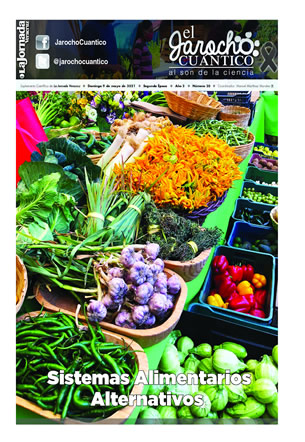ECOPOL: Article on GB Prison Garden in La Jornada
ECOPOL Director Juan Manuel Martínez sent us the following letter and translation of a thoughtful and inspiring article from a prominent Mexican journal about the GROW BIOINTENSIVE method being used in a prison garden program. You can access the entire supplement in Spanish here. On May 9th, 2021, La Jornada—a Mexican newspaper distributed nationwide—published a supplement with several articles about organic agriculture and local markets that consume their products. The article on page 5 called “From the Garden to Your Table” by psychologist Helen Juárez talks about the garden located in the prison facilities of Ciudad Guzmán, Jalisco in which the prisoners are growing vegetables with the Biointensive Method. The article also talks about the impact the garden has on their diet and their spirit. I taught three workshops there in 2019, and during the last workshop one of the participants said something that impressed me profoundly: “When I work in the garden, I do not feel like a prisoner”. In the translation of the article, we omitted some of the recipes the prisoners use to eat the garden’s products (you can read them online). The article on page 6 talks about local markets—organized by the University of San Luis Potosí where I also taught some workshops—that sell organic products; some of the products sold there are part Biointensive. Note: The laws and regulations of those establishments forbid the introduction of cameras or mobile phones, that is why we do not have pictures. To date the main garden has more than 40 beds and there are 12 prisoners who want to become certified teachers. This process was interrupted because of the pandemic and we will resume activities when it is over. From the Garden to Your Table Urban agriculture is an activity that during recent decades has been more and more present in multiple places, from gardens and terrace roofs to schools playgrounds and institutions. The art of producing your own food can come with original ways to add fresh food to your diet. An example of that is the therapeutic gardening project implemented by the University of Guadalajara in the Centro Integral de Justicia Regional de Ciudad Guzmán, Jalisco. This activity, under my supervision, is an extension university project that started in November of the year 2017. Inside the penitentiary, our intervention takes place in the “Therapeutic Community”, a program inside the prison that focuses on the rehabilitation of the inmates who are trying to stop using drugs. Since our intervention started, we redesigned the areas that had the potential to produce in order to replace the system in which you sow in (rows), with beds to use the Biointensive Method. The efficiency of this method has made it possible to market the vegetable surplus and even to produce seeds. The money that comes from the sale of vegetables and seeds is used to meet the needs of the prisoners. The generous production of vegetables has had a positive impact on the people that have participated in this activity because now they eat more fresh food. Arugula, kale, and mizuna are some of the crops that are here to stay. None of these plants were known, and for some their flavor, even when it was new, was also pleasant. Little by little these new crops conquered the palate of both the prisoners and the staff in charge of the area. Proof of this is that some of these crops have been incorporated harmoniously into some of the recipes that three people have shared with us. These people are currently participating in the "Therapeutic Community" program. To share this information, I have asked the authors for their authorization. For confidentiality reasons and with the purpose of safeguarding their identities, I have changed their names. José describes in detail how he prepares his purple cauliflower ceviche (raw fish marinated in lemon juice). First, he places particular emphasis on the cooking point: “it has to be something in between, neither raw nor very cooked”. Once you have the right cooking point, you chop the cauliflower and marinate it with lemon, salt, Maggi™ sauce, and pepper. Then you chop the onion, tomatoes, green chili, coriander, and the carrots. Once all the ingredients are ready, you mix them and ready. José told us that when he prepared this recipe, most of the ingredients were taken from the garden. When we asked him when had been the last time he had eaten that dish, he got quiet, tried to remember and said: “that was 9 years ago”. I also asked him how he felt when he tried this recipe again. He grinned from ear to ear, lowered his head a little and said: “It made me think of my grandma’s food”. Other recipes shared by the inmates included a “Community Soup” of vegetables and pasta, and two different salads, one of mixed kale, arugula, chard, mizuna, and strawberries garnished with sour cream and peanuts, and the other of kale, chard, spinach, mizuna, tomato, beet, apple and guava dressed with mayonnaise and tuna. These recipes are an example of how our relationship with food goes beyond the simple fact of producing food and taking it to our tables. Our food is creativity, flavor, vitality, energy but it is also a way to preserve memory, emotions, and affections. If our dear readers have read up to these final words, we kindly invite you to prepare some of the recipes we shared here. Without doubt you will be surprised by the singularity of their flavors. If our readers do not know some of the crops here mentioned, then we invite you to visit the street markets and markets where local producers sell their crops; they usually have a bigger variety of noncommercial vegetables. If time and space allow it, we also invite you to make incursions into producing your own food. ♥
top | Newsletter Home |Table of Contents| Archive
|



